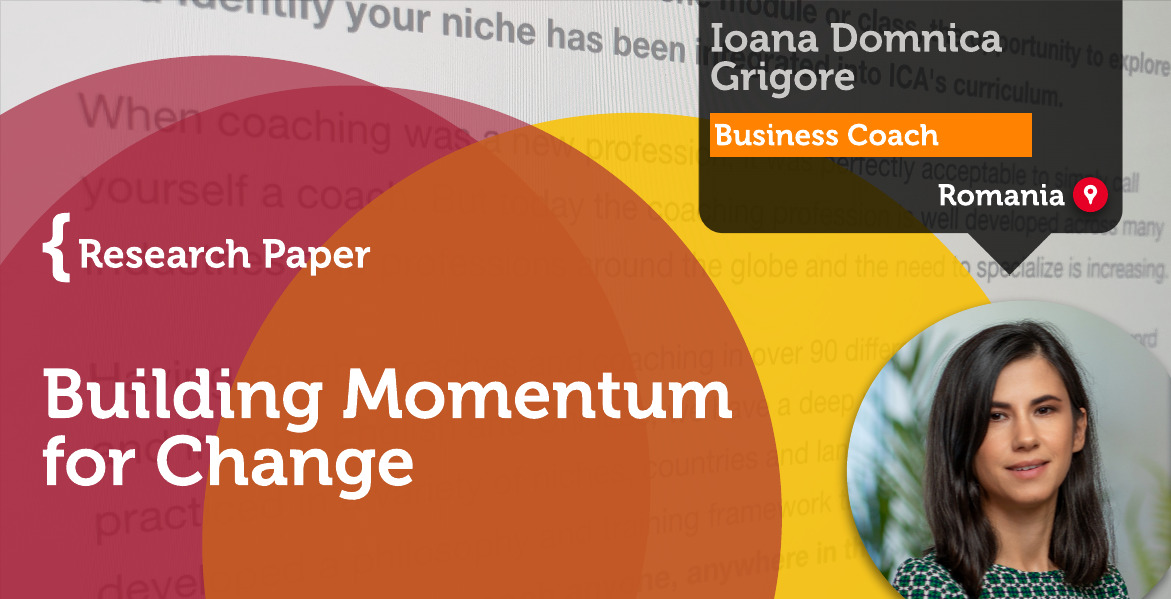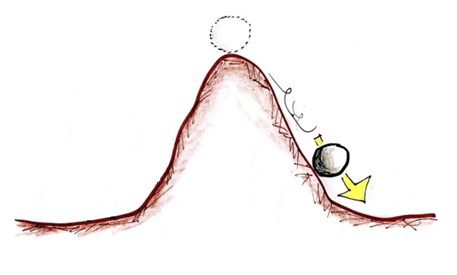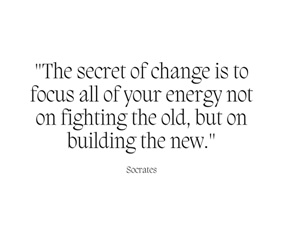A Research Paper By Ioana Domnica Grigore, Business Coach, ROMANIA

About Momentum
Momentum is generally used to describe increasing forward motion. A boulder rolling down a hill gains momentum. Momentum implies that, like a boulder rolling down a hill, something with momentum will continue moving forward on its own.
 This is also sustained by Newton’s First Law, also known as the Law of Inertia: “Objects at rest tend to stay at rest unless acted on by an outside force. Objects in motion tend to stay in motion unless something stops their momentum”.
This is also sustained by Newton’s First Law, also known as the Law of Inertia: “Objects at rest tend to stay at rest unless acted on by an outside force. Objects in motion tend to stay in motion unless something stops their momentum”.
Put another way, achievers (people who get into a successful rhythm) grow to be attaining more….once they get going.
When someone is actively moving toward a goal, you, as a coach, have thousands of opportunities to spark change. Action-driven person thinks of themselves differently and with more confidence. But if a person is doing nothing, you need to reach deep into their psyche through coaching sessions to spark a change. Therefore the road is harder and longer.
Momentum is not only an aspect of physics. It is also a feature of the human experience that is often overlooked and underutilized.
When properly designed, momentum generates flow in one’s life. Why is living in flow so important? Mihaly Csikszentmihalyi defines the concept of flow in his book: “The state in which people are so involved in an activity that nothing else seems to matter. The experience itself is so enjoyable that people will do it even at great cost.” By extrapolation, constantly living in flow results in a meaningful and enjoyable life.
How Momentum Works in Real Life
Momentum is powerful. So powerful that in the sports world an opposing team will do just about anything to interrupt the pattern and cause momentum to stop by calling a timeout, stopping the clock, or causing a foul or penalty.
But what is the most powerful regarding momentum is that even when obstacles get in the way (and this will happen), momentum has the power to transfer its energy through objects in your path. Therefore, in time, momentum makes everything easier and obstacles easier to surpass.
Here Are Some Examples of the Momentum at Play in Real Life.
Momentum has played a great role in Michael Phelps’ life resulting in winning a legendary eight gold medals at the 2008 Summer Olympics in Beijing. Working with his coach, Bob Bowman, Phelps honed his talents over twelve years. Together they built routines and rhythms and developed a consistency of performance that prepared Phelps to catch momentum just at the right time: the Olympic Games. Phelps and Bowman’s relationship is legendary for its scope and ambition: Bowman required such consistency when it came to practice that one of Phelps’ most vivid memories is when Bowman allowed him to finish a training session 15 minutes early so he could get ready for a middle-school dance.
In 2001, the year Apple released the iPod, they went from 30% revenue growth to -33%. Consistent growth only came in 2004 (up to 33%) and 2005 when Apple catapulted to 68% revenue growth. Since then, momentum helped Apple to dominate the digital music distribution for years with iTunes.
Google was a small, struggling search engine for a while, but today it owns more than 60% of its market. YouTube, the video-sharing space created in February 2005, officially launched in November of that year. But it wasn’t until they featured the “Lazy Sunday” digital short that originally aired on Saturday Night Live that people started going to YouTube. That YouTube video clip went immediately viral: it got more than 5 million views before NBC asked to have it taken down. By then there was no way to catch them. Today YouTube owns more than 60 percent of the video market.
These examples confirm two things: the power of momentum and the patience and persistence one has to have until reaching it. As you can see, momentum is not easily obtainable. It takes time and persistence even when the going gets tough, but it’s worth it as its impact is persistent too.
That’s why momentum is a very powerful and useful tool in generating and sustaining change.
Building Momentum for Change Through Coaching
As you’ve already learned so far, building momentum is not easy: getting started is slow going, then the first step is the hardest. One step, two steps, three steps and you feel you’re getting nowhere. But after a long and hard effort, you get going and, once you get going, the momentum makes it easier to happen. Adopting any change works the same way. You get started by taking one small step, one action at a time. Progress is slow, but once a newly formed habit has kicked in, momentum helps success and results compound.
Motivation is the way of change. Momentum is the how.
As Julian Stodd was saying, “the primary message of the Change Curve framework is the move from being Resistant to change, through to Constrained, then finally to Dynamic. The Resistant person loses momentum whilst the Dynamic one builds it.”
 Several methods can be used for driving and sustaining the dynamism within your client. The most common one is using the client’s intention to change. As adults, we are internally motivated and self-directed which means that to learn new things or to make a sustainable behavior change there must be intent.
Several methods can be used for driving and sustaining the dynamism within your client. The most common one is using the client’s intention to change. As adults, we are internally motivated and self-directed which means that to learn new things or to make a sustainable behavior change there must be intent.
Unfortunately finding an intent for change is not that easy because of the pattern called “escalation of commitment”. The psychologist Adam Grant explains how this works in his book “Think again”. When we dedicate ourselves to a plan and it isn’t going as we hoped, our first instinct isn’t usually to rethink it. Instead, we tend to double down and sink more resources into the plan. This pattern is called escalation of commitment and it happens because we’re rationalizing creatures, constantly searching for self-justifications for our prior beliefs as a way to soothe our egos, shield our images, and validate our past decisions.
 The coaching process can help the client break this pattern through exploration, reflection, and powerful questioning. Once the pattern is removed, the road to finding intent for change is clear. Here are the steps for intentional change coaching:
The coaching process can help the client break this pattern through exploration, reflection, and powerful questioning. Once the pattern is removed, the road to finding intent for change is clear. Here are the steps for intentional change coaching:
- Through exploration the coach helps the client create a sense of urgency for change (“What is the gap between where I am and where I want to be?”):
- The coach supports the client in establishing the goal, the ideal self;
- Next, the coach and coachee should explore where the coachee is currently at the real self.
Through this process of facilitated reflection, the coach can create an intrinsic tension within the coachee by drawing out the gap between the “real” and the “ideal self”. This tension is uncomfortable and the client will want to eliminate it, so a sense of urgency starts to emerge.
- The coach helps the client manage the tension by creating goals that will close the gap (“What are the things that I can work on to start closing the gap?”). The coach helps the coachee to explore opportunities, experiment and practice new behaviors and find support systems that propel him forward (such as people and resources).
- The coach supports the client to continue and sustain the change journey (“Has the gap changed?”, “Do I need to review my goals?”, “Is my real self changing?”, “Am I getting closer to my ideal self?”). Coaching is an ongoing process and working through this process helps to build sustained behavior change because the focus is always on the intent: “Where do I want to get to?”. Sustainable change does not come immediately, so it may be that the first few times the client reviews their real self, or they may not feel they are moving closer to their ideal self, or they might lose the motivation, etc. However, to continue the change process it will be important to again find the level of tension necessary to uncover the motivation for change and so the process begins again.
 Another tool for driving and sustaining the dynamism within your client is his imagination. There is no more powerful tool than this one when trying to spark motivation
Another tool for driving and sustaining the dynamism within your client is his imagination. There is no more powerful tool than this one when trying to spark motivation
Coming back to sports, one method that athletes’ coaches often use is painting the picture of the desired outcome – the picture of what they want to experience, how they want to carry themselves, every little detail about walking onto the winner’s deck, raising the trophy, kissing the medal. The same can be used with clients – knowing where they are heading builds motivation and this, in return, builds momentum:
- What do you feel like?
- What are you thinking?
- What are you thinking when you get ready every morning?
- What are you sensing?
- What are you saying to yourself?
And finally:
- What can you do today to get you to that spot?
No matter the method used, as a coach you have mainly three tasks:
- to seize the opportunities that reinforce stronger habits and change in client’s mindset
- to help the client with accountability
- to celebrate wins together and help draw learnings for a brighter future
Tools for Clients to Keep the Momentum
As we all already know, coaching is not about the coach, but about the client. Of course, the coach will be committed to supporting the client’s journey through change, but the client needs to be aware of several tips and tricks for daily use. These tips and tricks will help keep the momentum, even when the coach is not present:
- Building routines and rhythms into daily disciplines
- Staying consistent over a long enough period
- Self-monitoring to recognize when the unhelpful belief or thought is occurring
- Use mindfulness to interrupt the series of negative thoughts and reframe them into positive ones
 Act as a “third person” (the coach) or witness to question thoughts and assumptions
Act as a “third person” (the coach) or witness to question thoughts and assumptions- Develop positive self-talk
- Give up excuses
- Change environmental factors and design environmental cues
- Reflect on successes and failures
- Design rewards
- Start over if you need to
I would conclude that momentum is mainly about intention, motivation, persistence, and consistency. I always say to my clients that momentum is like a single wave roller-coaster: the machine puts a lot of effort into climbing the hill, but once on top, first, there is an extraordinary view (of all the possibilities that lay ahead), and second, you need to prepare yourself for one HELL OF A RIDE!!!
References
https://salesenablement.pro/
https://hbr.org/
http://blog.coach.me/
https://www.turningpointbizcoach.com/
https://www.psychologytoday.com/
https://conversationswithimpact.co.uk/
https://julianstodd.wordpress.com/
https://www.aitsl.edu.au/
https://medium.com/
Darren Hardy. “The Compound Effect”
Adam Grant. “Think Again”